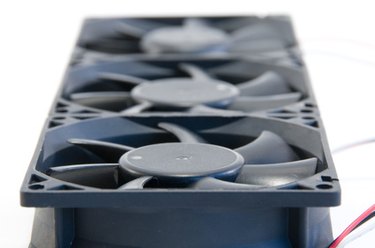
Exhaust fans are available in the standard model and the inline model. While their design varies, both types work to expel vapors from inside the home. Deciding which model to install can be determined by a home's design and space requirements.
Function
Video of the Day
The function of standard and inline exhaust fans is to remove vapors from the home created through use. This can include bathroom functions, such as showering or bathing. In kitchens where a range is not present, an exhaust fan can expel smoke and cooking vapors from the area. The reduction of vapors not only reduces related odors and fumes, but it can also reduce moisture.
Video of the Day
Standard Exhaust Fan
The standard exhaust fan is mounted just above the ceiling, with an intake vent cut into the ceiling below and an outlet that extends to the roof. The fan works by creating suction that pulls air up through the downward vent. As the air is sucked up, the fan blows it out the other end toward the roof vent, where it is expelled from the house. Standard exhaust fans are available with light kits as an added design feature.
Inline Exhaust Fan
The inline exhaust fan works the same way as the standard exhaust fan, but the design is different. The inline fan is mounted to a joist in the attic. One duct runs from the fan to a ceiling vent. Another duct runs from the fan to a roof vent. The duct connected to the ceiling sucks air from below into the fan. The fan then blows that air into the other duct that connects to the roof vent. This discharges the air from the house.
Installation
The standard exhaust fan is typically easier to install but is limited as to where it can be placed. Since this type of fan mounts at the ceiling level, weight and space requirements can sometimes be an issue. This is especially true for drop-in ceilings, which require standard exhaust fans be suspended from attic joists. With the inline exhaust fan, no weight is ever applied at or near the ceiling level. The duct that extends from the fan to the ceiling vent also allows the fan to be placed a greater distance away. This can reduce fan noise.
Mold and Mildew Prevention
Not only do exhaust fans remove odors and smoke, but they can also prevent mold and mildew growth. Mold and mildew typically form in bathrooms, where relative humidity can exceed 60 percent. An exhaust fan removes water vapor or steam in the air to reduce relative humidity levels. This prevents mold and mildew from forming.
Price
Standard exhaust fans and inline exhaust fans are comparably priced. Prices can vary based on light kits and motor features like noise reduction and air-flow ability, measured as cubic feet per minute or CFM.